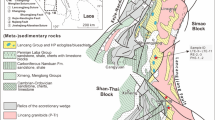Abstract
The geochemistry of formation waters in the Molasse basin of Upper Austria has been investigated to ascertain the extent of meteoric water replacement of the connate interstitial fluids in these sediments. The chemistry, isotopic composition, and dissolved gas contents of the groundwaters and of oil and gas associated brines have been determined. The most superficial sediments of the basin, the Innviertel (Miocene), have been completely flushed by meteoric waters within the last 200 ka. The underlying Hall and Puchkirchen formations (Miocene/Oligocene) form gas reservoirs for biogenic methane, and the associated formation waters are chemically and isotopically modified connate brines of the original marine deposition. In the northeastern part of the basin, the connate brines of the deeper sediments (Cretaceous/Jurassic) have been partially or completely replaced by meteoric waters, whereas in the south of the basin these sediments contain high salinity fluids which are substantially of connate origin. These conclusions are supported by the stable isotope composition of the various brines. Oil-associated brines from the Eocene sediments contain large amounts of dissolved radiogenic40Ar, which suggests that the oils have migrated from high-temperature environments. This is in contrast with the Puchkirchen, for which the observed absence of radiogenic40Ar suggests that the biogenic methane has been formed in situ. The4He contents of these brines and of the Cretaceous/Jurassic groundwaters are, however, less than those in the overlying Puchkirchen formation and suggest that He has been removed from the deeper sediments as a result of flushing by meteoric water. The ratios of dissolved methane and nitrogen to argon increase with increasing ammonium content of the formation waters. All of these parameters may be used as indices for the maturation of the system. The heavy noble gases, Kr and Xe, are abnormally abundant in the dissolved gases, and this is attributed to geochemical concentration of these gases by adsorption onto shales in the sediment sequence. The overall geochemical situation confirms the existence of separate hydraulic systems with little interconnection in the several overlying geological horizons.
Similar content being viewed by others
References Cited
Andres, G., and H. Frisch, 1981, Hydrogeologie und Hydraulik im Malmsarst des Molasse-beckens und der angrenzenden Frankisch-Schwabischen Alb: Die Thermal und Schwerfelwasservorkommen von Bad Gögging, Schriftenr. Bayer, Landesamtes Wasserwirtsch, v. 15, p. 108–117.
Andrews, J. N., 1985, The isotopic composition of radiogenic helium and its use to study groundwater movement in confined aquifers: Chem. Geol., v. 49, p. 339–351.
Andrews, J. N., J. E. Goldbrunner, W.G. Darling, P. J. Hooker, G. B. Wilson, M. J. Youngman, L. Eichinger, W. Rauert, and W. Stichler, 1985, A Radiochemical, hydrochemical and dissolved gas study of groundwaters in the Molasse basin of Upper Austria: Earth and Planet. Sci. Lett., v. 73, p. 317–332.
Andrews, J. N., and D. J. Lee, 1979, Inert gases in groundwater from the Bunter Sandstone of England as indicators of age and palaeoclimatic trends: J. Hydrol., v. 41, p. 233–252.
Andrews, J. N. and G. B. Wilson, 1986, The composition of dissolved gases in deep groundwaters and groundwater degassing: Geol. Assoc. Canada, Special Publication, in press.
Bernatowicz, T. J., F. A. Podosek, M. Honda, and F. E. Kramer, 1984, The atmospheric inventory of Xenon and noble gases in shales: the plastic bag experiment. J. Geophys. Res. v. 89, p. 4597–4611.
Bloch, S., and R. M. Key, 1981, Modes of formation of anomalously high radioactivity in oil-field brines: Bull. Am. Assoc. Petroleum Geol., v. 65, p. 154–159.
Clayton, R. N., I. Friedman, D. L. Graf, T. K. Mayeda, W. F. Meents, and N. F. Shimp, 1966, The origin of saline formation waters: 1. Isotopic compostion: J. Geophys. Res., v. 71, p. 3869–3882.
Degens, E., J. M. Hunt, J. H. Reuter, and W. E. Reed, 1964, Data on the distribution of amino acids and oxygen isotopes in petroleum brine waters of various geologic ages: Sedimentology, v. 3, p. 199–225.
Goldbrunner, J. E., 1984, Zur Hydrogeologie des oberösterreichischen Molassebeckens: Steir. Beitr. z. Hydrogeologie, v. 36, p. 83–100.
Graf, D. L., 1982, Chemical osmosis, reverse chemical osmosis, and the origin of subsurface brines. Geochim. Cosmochim. Acta, v. 46, p. 1431–1448.
Hitchon, B., and I. Friedman, 1969, Geochemistry and origin of formation waters in the western Canada sedimentary basin-I. Stable isotopes of hydrogen and oxygen. Geochim. Cosmochim. Acta, v. 33, p. 1321–1349.
Malzer, O., 1981, Geologische Charakteristik der wichtigsten Erdölung Erdgastrager der oberösterreichischen Molasse: Teil II: Die Konglomerate und Sandstein des Oligozans: Erdöl Erdgas Z., v. 97, p. 20–28.
O'Neil, J. R., and Y. K. Kharaka, 1976, Hydrogen and oxygen isotope exchange reactions between clay minerals and water: Geochim. Cosmochim. Acta, v. 40, p. 241–246.
Podosek, F. A., M. Honda, and M. Ozima, 1980, Sedimentary noble gases: Geochim. Cosmochim. Acta, v. 44, p. 1875–1884.
Polesny, H., 1983, Verteilung der Ol und Gasvorkommen in der oberösterreichen Molasse: Erdöl-Erdgas Z., v. 99, p. 90–102.
Schoell, M., 1977, Die Erdgase der suddeutschen Molasse-Anwendung von D/H und13C/12C Isotopenanalysen zur Klarung ihrer Entstehung: Erdöl Erdgas Z., v. 93, p. 311–322.
Schoell, M., 1983, Genetic characterisation of natural gases: Bull. Am. Assoc. Petroleum Geol., v. 67, p. 2225–2238.
Author information
Authors and Affiliations
Rights and permissions
About this article
Cite this article
Andrews, J.N., Youngman, M.J., Goldbrunner, J.E. et al. The geochemistry of formation waters in the molasse basin of upper Austria. Environ. Geol. Water Sci 10, 43–57 (1987). https://doi.org/10.1007/BF02588004
Issue Date:
DOI: https://doi.org/10.1007/BF02588004




